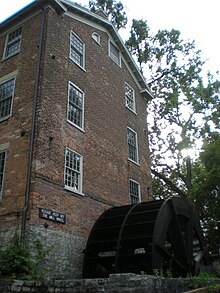Graue Mill
Settling in what was the farming village and early transportation hub of Fullersburg, Illinois, formerly named Brush Hill, he and William Asche (whose brother-in-law, Henry Fischer, built a wind-powered grist mill in what is now Mount Emblem Cemetery) filed claim in 1849 to a tract of damp, clay-rich bottomland along the banks of Salt Creek that was home to a sawmill that burned down the year before.
The Graues built a kiln on their farmstead, fired the bricks, and slowly raised the new structure and waterwheel into place from the on-site building materials.
[2] The ditching and draining of the Graue Mill farmstead was typical of German-American settlement patterns in the Midwest in the 1840s and 1850s, as the thrifty German emigrants found assets in tracts of land that had been left behind by earlier, English-speaking frontiersmen and women.
Quarried in France, the buhrstones, a type of millstone, were carefully dressed by specially trained craftsmen so as to form two level, gritty surfaces that would pulverize the grain between them.
The mill is one of three authenticated Illinois stops on the Underground Railroad, the subversive movement that helped fugitive slaves escape from the American South to Canada.
[3] The Graue Mill is located at 3800 S. York Road, on the banks of Salt Creek in Oak Brook, Illinois, and is surrounded by Fullersburg woods.

